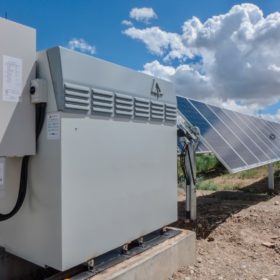
Matt Harper, chief commercial officer of newly-merged British-Canadian vanadium redox flow battery business Invinity Energy Systems has spoken to pv magazine about the VS3-022 Battery Unit it is marketing for grid scale solar-plus-storage projects and why it may be a better bet than lithium-ion.
With London-based private company redT energy and transatlantic peer Avalon Battery Corp last month announcing a £57.7 million merger ($71.6 million) to form vanadium redox flow battery manufacturer Invinity Energy Systems, Matt Harper, chief commercial officer of the new entity, has spoken to pv magazine about the VS3-022 Battery Unit Invinity is offering for grid scale solar-plus-storage projects.
The Invinity representative said the company, formed through a reverse takeover by the U.K. company of its listed counterpart, has more than 40 operating flow battery storage projects. “The majority of our fleet is in service alongside megawatt-scale PV projects,” said Harper. “This includes a 1 MWh project in Iowa, USA, which is supporting a 1 MW behind-the-meter PV array, and a 2 MWh energy storage system in Qinghai province, China, that is installed as part of a 1.6 GW solar park.”
With Invinity targeting the utility scale market, its typical customer wants at least 1 MW of solar-plus-storage capacity, according to Harper.
The VS3-022 battery has a reported storage capacity of 220 kWh and continuous maximum DC power of 76 kW. Annual degradation of storage capacity is indicated at less than 0.5% and energy efficiency annual degradation is less than 0.1%, according to the manufacturer. The 6.058 x 2.438 x 2.4m battery has an ambient operating temperature range of –5 to 45 degrees Celsius and a lifetime of 25 years and 20,000 cycles, according to Invinity, although Harper claimed the product does not degrade at all with use.
Cost
“Industry analysts estimate fully installed lithium-ion prices at around $450/kWh for C&I [commercial and industrial] projects and our vanadium redox flow batteries are the same price or cheaper on an upfront cost basis,” said Harper, who said Invinity products offer a lower levelized cost of storage than lithium-ion alternatives.
“In applications where the batteries are used daily, we’re around 30% below lithium today, on a levelized basis, with a clear path to 60% below lithium within two to three years,” added the chief commercial officer.
The flow batteries, said Harper, are ideally suited to heavy cycling applications and those requiring long duration charging and discharging for more than three hours, for example when coupled with intermittent renewables or to provide grid services. “They are well suited for use alongside utility scale solar PV plants and in commercial and industrial applications, as for example in data centers, water treatment sites, distribution centers and recycling facilities – especially when coupled with solar as they can provide significant energy savings, access to new revenue streams and [can] help to meet carbon reduction targets more quickly.”
Although such devices are not appropriate for household systems, vanadium flow batteries can be used for community microgrid and “end of street” applications, Harper told pv magazine.
Potential
Invinity says its battery offers five key benefits. “In addition to the significant costs benefits I’ve already stated,” said Harper, “our systems are fully recyclable, they don’t degrade with use, they are longer-duration and longer-lifetime than lithium and they pose no fire risk. In fact they are more likely to put out a fire than start one.”
The Invinity spokesman said customers are beginning to explore alternatives to lithium-ion batteries. “There are a range of predictions out there for the potential growth of the flow market over the coming years, with some experts predicting that it could reach £3.5 billion by 2028,” said Harper.
The chief commercial officer refused to comment on long-term cost reduction plans but pointed out the cost of Avalon’s vanadium flow technology has fallen by half since commercial launch of the Oakland business’ second generation product in 2017.
With the new company active in Europe, North America, Asia, Australia and Africa with more than 10 MWh of systems installed, Harper added: “The west-coast of the USA is a very interesting market and there’s also huge potential in Australia, Germany and some Eastern European countries that are reforming their electricity markets.”
Lắp đặt điện mặt trời Khải Minh Tech
https://ift.tt/2X7bF6x
0906633505
info.khaiminhtech@gmail.com
80/39 Trần Quang Diệu, Phường 14, Quận 3
Lắp đặt điện mặt trời Khải Minh Tech
https://ift.tt/2ZH4TRU
Không có nhận xét nào:
Đăng nhận xét